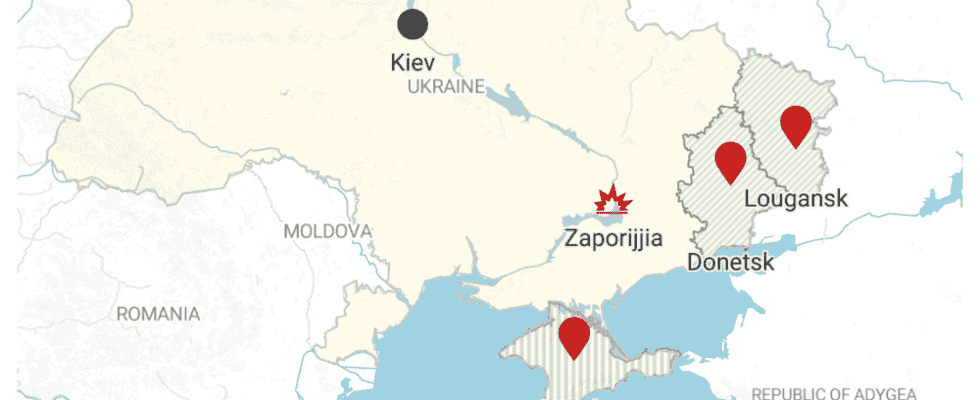The world held its breath that night. Russian tanks fired very early on Friday March 4 at the Ukrainian nuclear power plant in Zaporijjia, the largest in Europe, causing a fire and raising fears of a huge disaster.
The attack did not affect any essential installation of the plant, whose nuclear security was not affected, according to the Ukrainian authorities and the International Atomic Energy Agency (IAEA). Ukrainian President Volodymyr Zelensky accused Moscow of using “nuclear terror” and called for “immediate European action” to “prevent Europe from dying from a nuclear disaster”.
- Where is the central located?
The Zaporijjia nuclear power plant is located in southern Ukraine on the Dnieper River, 525 kilometers from Chernobyl. Due to its position between annexed Crimea and Donbass, which includes two pro-Russian separatist regions, theaters of fighting since 2014, it has already experienced several incidents.
The Zaporizhia nuclear power plant is located between Donbass and Crimea.
The Express
It is the largest nuclear power station in Europe, with a total capacity of nearly 6,000 megawatts, enough to supply electricity to around four million homes. In normal times, the site produces a fifth of the country’s electricity and almost half of its nuclear energy.
Construction of the first reactor began in 1979, when Ukraine was part of the Soviet Union. Inaugurated in 1985, the plant now has six VVER-1000 reactors of Soviet design, the last of which was commissioned in 1995. These reactors have a lifespan of between 40 and 60 years, or more with the advance of technologies.
Ukrainian authorities warned on Friday that a Russian bombardment had caused a fire in a building dedicated to training and in a laboratory. After several hours of uncertainty, the scene was secured and the reactors were “safely shut down”, according to US officials. The fire, which caused no casualties, was extinguished by Ukrainian firefighters at 6:20 a.m.
Russian forces now occupy the territory of the plant according to the nuclear site inspection agency, assuring that the personnel ensured the exploitation of the site. “The territory of the Zaporizhia nuclear power plant is occupied by the Armed Forces of the Russian Federation. Operational personnel control the energy blocks and ensure their operation in accordance with the requirements of technical regulations for operational safety,” the official said. Ukrainian state body.
- How does the central work?
These pressurized water reactors are considered to be among the safest. Their design comes from those fitted to nuclear submarines and differs from those of Chernobyl, moderated with graphite and initially designed to produce plutonium and not electricity. The power plants at Balakovo, on the Volga in southern Russia, and Kozloduy, on the Danube in Bulgaria, have similar technology.
The Zaporijjia VVER-1000s are powered by fuel enriched in the fissile isotope Uranium-235. They work thanks to the steam heated by the heart. Unlike other reactors, the nuclear-contaminated steam is not used to turn the turbines, but to heat another circuit of uncontaminated steam which then turns the turbines. This technique makes it possible to maintain a relatively low level of radioactivity for the employees of the plant.
- What are the levels of radioactivity?
The background radiation around the site was 0.1 microsievert per hour this Friday morning, according to the plant operator, a level below the world average and well below that of an airplane flight or a x-ray. During the Chernobyl disaster, the level of radioactivity was millions of times higher, at 300 sieverts per hour.
After the Russian military operation against Ukraine in 2014, Kyiv developed safety protocols for the physical protection of nuclear facilities in the country, with regular inspections, vulnerability assessment and implementation of automated control systems Datas. Air defense has also been reinforced over Zaporizhia.
